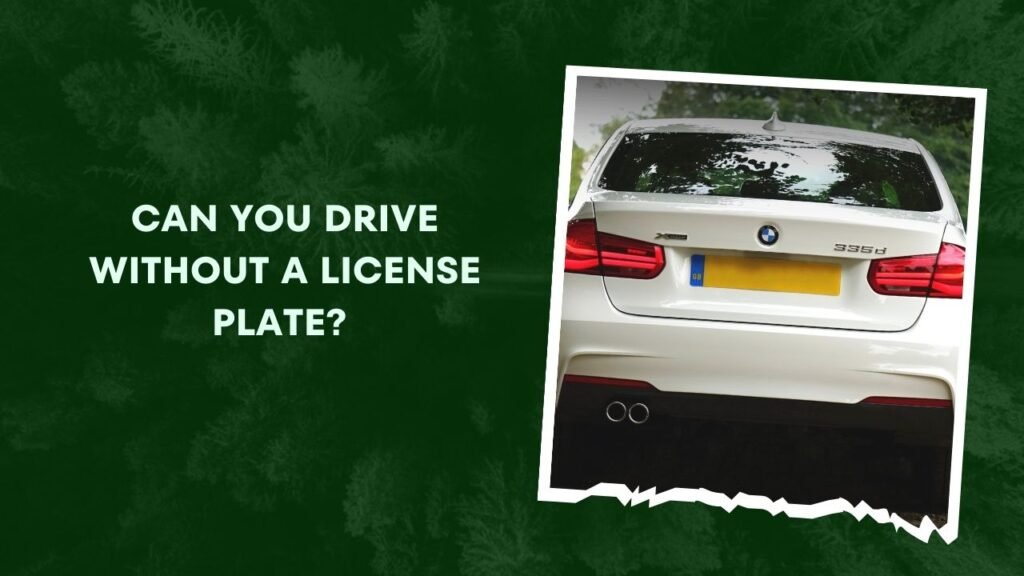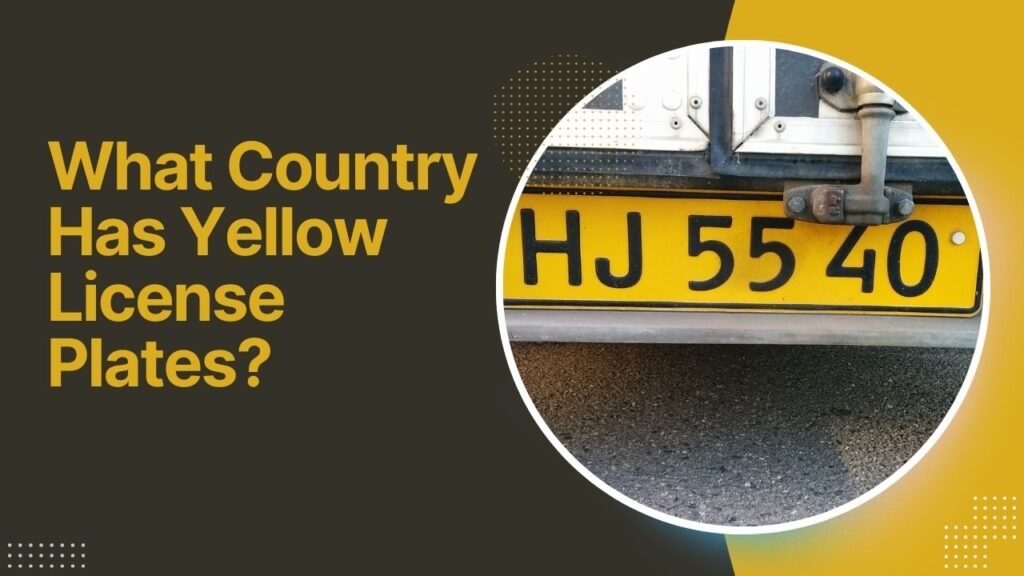Can You Drive Without A License Plate? Driving without a rear license plate is illegal across the U.S., though some states don’t require a front plate.
Driving in the United States requires compliance with a variety of legal regulations, and one of the most critical is the display of license plates.
Whether you’re a new driver or simply curious about the rules, understanding the requirements for license plates can help you avoid fines, legal issues, and potential safety concerns.
This article will explore whether you can drive without a license plate, the rules in different states, and what happens if you fail to comply.
Contents
What Are License Plates?
License plates are official identifiers assigned to vehicles by state authorities. [Can You Drive Without A License Plate?]
They typically consist of a unique combination of letters and numbers, along with other elements like the state name, registration year, and specialty design elements.
History of License Plates in the U.S.
The use of license plates in the U.S. dates back to the early 1900s. The first state to issue plates was Massachusetts in 1903, and over time, every state adopted the practice.
Initially, these plates were simple metal tags, but they have evolved to include security features like holograms and barcodes, enhancing their functionality and preventing counterfeiting.
Why Do Vehicles Need License Plates?
The primary purpose of license plates is to serve as a unique identifier for vehicles. [Can You Drive Without A License Plate?]
However, their importance goes beyond identification, contributing to public safety and administrative efficiency.
Vehicle Identification
License plates enable law enforcement and government agencies to track vehicles. This is especially crucial in situations involving stolen cars, traffic violations, or vehicular crimes.
By linking the plate number to a registered owner, authorities can quickly gather necessary information. [Can You Drive Without A License Plate?]
Public Safety and Accountability
In the event of an accident or a crime involving a vehicle, license plates help ensure that drivers can be held accountable.
For instance, hit-and-run incidents rely heavily on eyewitnesses or surveillance footage capturing license plate numbers to identify the responsible party.
Toll and Parking Management
Many toll systems and parking facilities use license plate recognition technology to streamline operations.
This allows for efficient toll collection without requiring drivers to stop, enhancing traffic flow and reducing congestion.
Legal Requirements Across the U.S.
The legality of driving without a license plate varies across the U.S., but in most cases, having at least one plate displayed on your vehicle is mandatory.
Rear vs. Front License Plate Laws
- Both Front and Rear Plates Required:
States like California, Texas, and New York require vehicles to display plates on both the front and rear. This ensures that the vehicle is identifiable from either direction, which is particularly useful for law enforcement and toll systems. - Only Rear Plates Required:
States such as Florida, Michigan, and Arizona only require a rear plate. This rule simplifies compliance for drivers and reduces costs for the state. [Can You Drive Without A License Plate?]
Temporary Exemptions
There are situations where driving without a permanent license plate is temporarily allowed.
For instance, when purchasing a new or used vehicle, dealerships often issue temporary plates or permits.
These temporary tags are valid for a specific period, usually 30 days, and allow the owner to legally drive while waiting for their permanent plates.
State-Specific Rules
Understanding the specific license plate requirements in your state is essential to ensure compliance and avoid penalties.
States Requiring Both Plates
In states like California, Texas, and New York, both front and rear plates are mandatory.
This dual plate requirement helps in identifying vehicles more effectively and enhances the functionality of systems like red-light cameras and toll collection.
States Requiring Only a Rear Plate
States such as Florida, Michigan, and Arizona allow drivers to operate vehicles with only a rear plate. [Can You Drive Without A License Plate?]
This regulation often applies to standard passenger vehicles but may exclude certain categories like commercial vehicles, which could have different requirements.
Exceptions and Special Cases
Certain vehicles may qualify for exemptions or different rules. For example, classic or antique cars often have special registration options that may include alternative plate display requirements.
Similarly, military personnel and diplomats may be issued distinctive plates that follow different regulations.
Penalties for Driving Without a License Plate
Driving without a license plate, or failing to display the required number of plates, can result in various penalties, depending on the state and specific circumstances.
Fines and Legal Consequences
Most states impose fines for driving without a proper license plate. These fines can range from $50 to $200, and in some cases, repeated violations may lead to higher penalties.
Some states may also require drivers to appear in court for failing to comply with license plate laws.
Impact on Insurance and Registration
Driving without a license plate can have broader implications for your vehicle registration and insurance. [Can You Drive Without A License Plate?]
Some insurance companies may view this as a violation, potentially increasing your premiums. Additionally, driving without valid plates may lead to the suspension of your vehicle registration.
Court Appearances and Record Implications
In more severe cases, such as driving with expired temporary plates or using fraudulent plates, you may be required to appear in court.
These violations can result in a mark on your driving record, affecting your ability to renew your license or register vehicles in the future.
Temporary Plates and Unique Situations
There are specific scenarios where driving without a standard license plate is permissible, often involving temporary plates or special circumstances.
Temporary License Plates
Temporary license plates are issued by dealerships or DMVs to new vehicle owners. These plates are valid for a limited time and allow the vehicle to be legally driven until the permanent plates are issued.
Temporary plates are typically made of paper or lightweight materials and must be displayed clearly. [Can You Drive Without A License Plate?]
What If My License Plate Falls Off?
If your license plate falls off due to an accident, wear and tear, or theft, it’s crucial to take immediate action. Most states require you to report the loss to your local DMV and apply for a replacement.
Driving without any plates, even temporarily, can still result in fines unless you have proper documentation explaining the situation.
Special Plates for Military and Diplomatic Vehicles
Military personnel and diplomats often have unique license plate requirements. These plates help identify their special status and may exempt them from certain state-specific regulations.
However, they must still adhere to federal laws and ensure their plates are valid. [Can You Drive Without A License Plate?]
See Also: Does Utah Require A Front License Plate?
How to Stay Compliant
To avoid fines, legal complications, and other issues, it’s essential to follow the proper procedures for obtaining, displaying, and maintaining your license plates.
Obtaining and Renewing License Plates
When registering a vehicle, you’ll be issued license plates by your state’s DMV. This process involves submitting proof of ownership, paying registration fees, and obtaining the appropriate plates.
It’s also crucial to renew your registration periodically to ensure your plates remain valid.
Replacing Lost or Stolen Plates
If your license plate is lost or stolen, report the incident to the police and your local DMV. [Can You Drive Without A License Plate?]
You’ll need to provide identification, proof of vehicle ownership, and possibly pay a fee to receive a replacement plate.
Checking State-Specific Regulations
Since license plate laws can vary, regularly reviewing your state’s regulations is a good practice. This is especially important if you move to a new state or purchase a vehicle from a different state.
Conclusion: Can You Drive Without A License Plate?
In the U.S., driving without a license plate is generally prohibited, though the specific rules vary by state. Some states require both front and rear plates, while others only mandate a rear plate.
Temporary exceptions exist for new vehicle owners, but it’s crucial to follow local regulations to avoid fines and legal consequences.
By ensuring your vehicle has the proper plates and is registered correctly, you can enjoy a smooth and lawful driving experience.
FAQs
Can I drive a newly purchased car without plates?
Yes, if you have a temporary registration or permit, which allows legal driving for a limited time.
What is the penalty for driving without a rear license plate?
Penalties vary by state but typically include fines ranging from $50 to $200. [Can You Drive Without A License Plate?]
Are there states with no front license plate requirement?
Yes, states like Florida, Michigan, and Arizona only require a rear plate.
How do I replace my lost or stolen license plate?
Report the loss to your local DMV and provide necessary documentation to receive a replacement.
Can temporary plates be used across state lines?
Generally, yes, but it’s essential to verify specific rules for each state you’ll be traveling through.

I’m Karsyn Marsh, a blogger from a small village in Texas. I enjoy writing about many topics, and right now, I’m focused on license plates. I share helpful information and facts on LicensePlateFacts.com.



